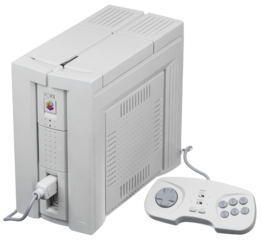PC-FX
From NEC Retro

| ||||||||||
| PC-FX | ||||||||||
|---|---|---|---|---|---|---|---|---|---|---|
| Manufacturer: NEC | ||||||||||
|
This short article is in need of work. You can help NEC Retro by adding to it.
The PC-FX (ピーシー エフエックス) is a video game console created by NEC as a successor to the PC Engine and its many add-ons and derivatives. After a protracted development timeline, it was released in Japan in December 1994.
Contents
Hardware
The PC-FX stands as a curious mid-point between traditional early-90s video game consoles and desktop computers (of which NEC already had a healthy stake in with the PC-9800 series line). It resembles a typical upright (albeit smaller) mid-90s PC, however is designed to play video games shipped on CD-ROMs with a traditional, six-button controller - the FX-Pad.
The CD drive is located on the top of the unit (a design also witnessed in the PC-8801 MC), and the console is designed to be expandable. No keyboard was ever manufactured for the PC-FX, meaning it was never suited to traditional office software such as word processing, but a mouse was created in the form of the FX-MOU, primarily used for strategy games. The PC-FX can be linked up to a PC-9800 series to act as a CD-ROM drive, however.
Technical Specifications
History
Development
Development on a successor to the PC Engine began in around 1990[1], initially, as with much of the PC Engine's technology, as a project led by Hudson Soft.
A 32-bit "HuC62" machine was first announced at a 20th anniversary event for Hudson in May 1992 at the Imperial Hotel in Tokyo, using five custom-made processors[2] to manipulate graphics; a "HuC6261 Color Palette Video Interface", "HuC6271 Full Color Animation Decoder", "HuC6272 Data Transmitter", "HuC6230 Sound Decoder Mixer" and most importantly a "HuC62320" 32-bit RISC CPU.
Little was said at this stage about the system's potential to play games; rather that it was a "multimedia" device applicable to computer-generated animation and presentations. A prototype was constructed, consisting of a large PCB, plenty of video and audio outputs, but hard-wired inputs, resembling more of a motherboard for a PC or arcade system than a video game console. A decision on what sort of physical media would be used for software had also not been made at the time.
By Summer CES 1992, NEC had come on board, and the project was being referred to as "Tetsujin" ("Iron Man"). NEC saw it as a means of clawing back Japanese video game market share once held by the PC Engine prior to the release of the dominating Super NES, and began talking of Tetsujin's credentials as a video game console.
Nevertheless, there was still an emphasis on its capabilities of displaying high resolution, 24-bit colour graphics[3]. Interest was raised by a demonstration of Super Star Soldier 3D, showing that the system was capable of rendering flat-shaded polygonal 3D graphics. Hudson's demo pre-dated many of the games credited with bringing 3D gaming to the masses, such as 1993's Virtua Fighter which would define the Sega Saturn for a short while.
Though there were rumours of a 1993, the Tetsujin project went quiet, and after announcements concerning the Sega Saturn and PlayStation, was re-worked from the ground up[2], becoming project "FX" in early 1994.
Unlike its rivals which reacted by adding more capabilities to their systems, NEC chose a radically different path, reducing the FX to a single CPU[2] (alongside other changes[1]). This meant a late 1994 release date was also pushed back to 1995[2].
50-60 people worked on the FX project (both from a design and engineering point of view)[1]. Hudson Soft continued to be involved in the PC-FX's development, having a say in the manufacture of some components[1], but the single CPU was now a NEC-born V810.
NEC had planned to sell 50,000 consoles in Japan per year[4]. It was never planned to replace the PC Engine outright (the PC Engine Duo-RX becoming the "standard" PC Engine configuration in 1994), but was to be a higher-end unit with its own selection of software.
Similar to the delays imposed on the Sega Saturn and PlayStation, NEC were cautious about releasing the system in North America due to fears the system would cost too much[1]. In the end, no PC-FX systems were officially released outside of Japan.
Release
Legacy
The PC-FX was considered by the Japanese public to be an expensive and underpowered system. Its lack of native 3D capabilities put it at a disadvantage against the Sega Saturn and Sony's PlayStation which had debuted in the same holiday season, and the console was largely shunned by third-party developers as a result. Only a hundred thousand units were produced as opposed to the millions of PC Engines, and the system did not leave Japan in any form, with even NEC citing price as a concern in Western markets.
Despite initial claims to the contrary, NEC imposed unusual directives on PC-FX developers, with software being skewed towards popular anime series with pre-rendered animated footage[5]. Throughout the system's life, virtually all software released for the machine capitalised on its ability to stream video (and load high quality stills) from CD. While polygonal 3D titles had been demonstrated alongside Tetsujin prototypes (most notably Super Star Soldier 3D), no 3D games were ever released on the PC-FX.
In early 1998 the console was discontinued, and NEC effectively left the home console business.
Magazine articles
- Main article: PC-FX/Magazine articles.